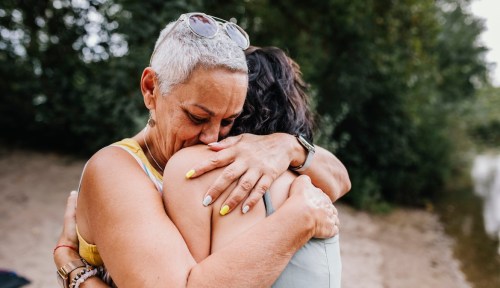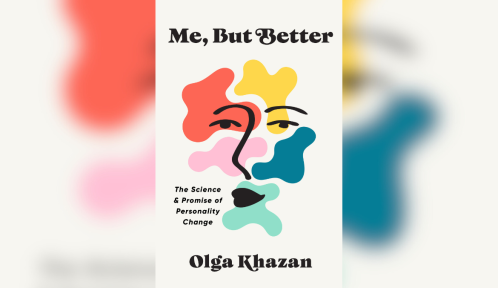Our editors independently select these products. Making a purchase through our links may earn Well+Good a commission
My life is full of people who have boundless reserves of creative energy: My sister has a seemingly endless list of ways to entertain her kids while she works from home; my friend paints abstract art as a side-hustle; and my co-worker shows up to every meeting armed with creative solutions to situations that have everyone else scratching their heads.
These various forms of creativity make me feel jealous. Despite being a writer—a profession many would describe as inherently creative—sometimes I feel like I’m on autopilot. Often, this feeling fills me with a sense of panic as to whether all my “good ideas” simply ran out. Since surely I’m not the only person who feels this way when navigating a creative block, I began to question what the best practices are for dealing with the worry that creative juices have run dry. How do you get a creative spark back?
For the answers, I called up Dare To Inspire co-author and leadership coach Allison Holzer, who not only penned a whole book on sustaining inspiration but also has a background in emotional intelligence and helps workplaces find creative solutions to various problems (as well as combat burnout). Here, Holzer explains what often leads a creative fire to be snuffed out in the first place—plus tips for how to be more creative and get that spark back.
Why someone may lose a creative spark
One big reason someone may feel less creative than they used to? Burnout. “Burnout is the opposite of inspiration,” Holzer says. She elaborates that there are different types of burnout—physical burnout (which includes not getting enough sleep), emotional burnout, and cognitive burnout—all of which can be creativity blockers.
Lack of self-advocacy is another potential creativity squelcher, Holzer says. “That’s the idea of feeling like you’re going to be unable to get everything done, or that things won’t get better. This can also get in the way of creativity, because you don’t feel like you have the confidence or courage to take action in new ways.”
The commonality of these culprits, Holzer says, is they can lead to living on autopilot—going through the motions in a way that’s uninspired, and certainly not creative. But, if you’re searching for tips for how to be more creative, you’re in luck. Below, find five simple steps that can lead to feeling rejuvenated.
How to be more creative in 5 easy steps
1. Get to the root issue of burnout
To pinpoint the reasons why you may be feeling burned out, ask yourself whether it’s physical burnout and getting more sleep and eating the right foods can help. Or is it more likely emotional burnout, and you’d benefit from more regularly scheduled self-care time in order to recharge? Do you feel a lack of self-advocacy and need to talk to a therapist about feeling hopeless or down? Whatever root issue is at the root of your inspiration slump, “it’s important to find ways to reduce stress to allow more energy and space to be creative,” Holzer says.
2. Connect to your purpose for the day
“It can be but doesn’t have to be a Big Thing,” Holzer says. “Purpose is a big driver of inspiration and creativity.” Asking questions about what you want to be that day and what type of impact you want to have in the next 12 hours can lead to thinking about creative ways to structure your time.
“It can be but doesn’t have to be a Big Thing. Purpose is a big driver of inspiration and creativity.” —Allison Holzer, leadership coach and creativity expert
What’s more is that when difficult circumstances arise (like, hello, handling a pandemic), Holzer says the opportunity presents to find new ways in which to interact with your purpose, though your default methods may not be an option anymore.
3. Find mini ways to recharge throughout the day
If you feel like you’re going nonstop, moving from one task on your to-do list immediately to the next, all day long, finding small ways to recenter your mind can be important. “One of my clients is a doctor and she uses the two minutes when she’s washing her hands—something she does many times throughout the day—as an opportunity just to take a few deep breaths and clear her mind,” Holzer says. “This is a meditation practice called mono-tasking, which is when you turn a mundane task—like brushing your teeth or washing the dishes—into a grounding, intentional ritual.”
4. Give yourself an opportunity to be bored
In addition to these mini breaks, Holzer also recommends carving out time in your schedule (for her it’s an hour-and-a-half, once a week) to do literally nothing. “Having unstructured time is something that we saw come up again and again when we were doing research and interviews for the book,” she says. “It just gives yourself breathing room and time when you’re not just going from one activity to another.”
Many people, she says, have their best ideas during this time, pointing to Lin-Manuel Miranda, who she says came up with the idea for Hamiltonwhile he was on the first vacation he took in years. If that isn’t an argument for doing nothing, I don’t know what is.
5. Spend time with people who inspire you (even if it’s just virtual time)
Holzer points out in her book that inspiration is contagious—even if what someone is excited about isn’t exactly the same as what you’re into. “The idea of inspiration being contagious comes from research on emotional intelligence,” she says. “All emotions are contagious, but we learned that inspiration is really contagious. If you’re with someone inspiring, you start to feel that energy, and it leads to feeling greater possibility in yourself.”
If you can’t think of anyone in your inner circle who has this type of energy, attend a lecture about a topic that interests you, spend time volunteering with others who are passionate about a specific cause, or go to a concert. Even doing these types of activities virtually works, Holzer says. “Yo Yo Ma recently streamed a mini-concert on Twitter, and even though you weren’t in the same room as him, you could still feel that energy and his inspiration,” she says.
The truth is, no force can actually take your creativity from you. If you feel like you’ve “lost” it, rest assured that you haven’t; you may just need to reset, rest, and adjust. Putting these five steps into place can help keep creativity sustained, and that flame burning bright.
Sign Up for Our Daily Newsletter
Get all the latest in wellness, trends, food, fitness, beauty, and more delivered right to your inbox.
Got it, you've been added to our email list.











